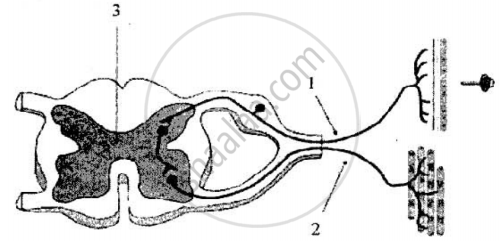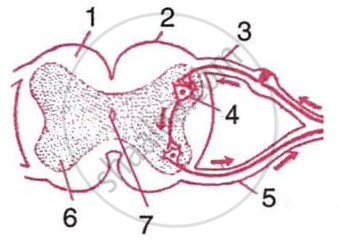Advertisements
Advertisements
प्रश्न
What is the role of the brain in reflex action?
उत्तर
Reflex actions are sudden responses, which do not involve any thinking. For example, when we touch a hot object, we withdraw our hand immediately without thinking as thinking may take time which would be enough to get us burnt. The sensory nerves that detect heat are connected to the nerves that move the muscles of the hand. Such a connection of detecting the signal from the nerves (input) and responding to it quickly (output) is called a reflex arc. The reflex arcs − connections present between the input and output nerves − meet in a bundle in the spinal cord.

Reflex arcs are formed in the spinal cord and the information (input) reaches the brain. The brain is only aware of the signal and the response that has taken place. However, the brain has no role to play in the creation of the response.
संबंधित प्रश्न
The diagram given below shows the internal structure of a spinal cord depicting a phenomenon. Study the diagram and answer the questions:

1) Name the phenomenon that is depicted in the diagram. Define the phenomenon.
2) Give the technical term for the point of contact between the two nerve cells.
3) Name the parts numbered 1, 2 and 3.
4) How does the arrangement of neurons in the spinal cord differ from that of the brain?
5) Mention two ways by which the spinal cord is protected in our body.
Name two parts of the body which contain receptors of chemical stimuli.
Explain the difference between of the following pair of terms :
cerebrum and cerebellum
Give the various functions of brain.
One of the following controls the peristaltic movements of alimentary canal. This one is :
(a) cerebrum
(b) cerebellum
(c) pons
(d) medulla
The contraction of pupil of the eye in the presence of bright light is an example of :
(a) Voluntary reflex
(b) Spinal reflex
(c) Cerebral reflex
(d) Adrenal reflex
When we touch a hot plate unknowingly, then this heat is sensed by a receptor P present in our fingers. The receptor triggers and impulse in neuron Q which transmits the message to an organ R which is a part of the central nervous system. Here the impulse is passed on to a neuron S which in turn passes it to a yet another neuron T. The neuron T passes the impulse to a tissue U in our arm. The tissue U then contracts and pulls our hand away from the hot plate.
(a) What is the name of (i) receptor P (ii) neuron Q, and (iii) organ R?
(b) What is (i) neuron S, and (ii) neuron T?
(c) Name the tissue U.
(d) What name is given to the phenomenon in which hand is pulled away quickly from the hot plate?
(e) Name the effector in this whole process.
A cylindrical structure P in our body begins in continuation with medulla and extends downwards. It is enclosed in a bony cage Q and surrounded by membranes R. As many as x pairs of nerves arise from the structure P. The structure P is involved in the reflex actions of our body and conduction of nerve impulses to and from another organ S of our body with which it forms CNS.
(a) Name the structure P.
(b) Name (i) bony cage Q, and (ii) membranes R.
(c) How much is x?
(d) Name the organs S.
(e) What are the reflexes involving structure P only known as?
Define voluntary and reflex actions. Give examples of each.
State whether the following is simple reflex, conditioned reflex or neither of the two.
Contraction of eye pupil
Define the following:
Reflex action
Explain the following term :
Conditioned reflex
State whether the following is simple reflex, conditioned reflex or neither of the two.
Lifting up a book
What type of reflex is the following?
Sweating in summer
Mention, if the following statement is True or False
Reflex action is a unit of nervous action
Which of the following is an example of unconditioned reflex?
How is the mode of action in beating of the heart different from reflex actions? Give four examples.
What kind of reflex is cycling?
Given alongside is a partial diagrammatic representation of a certain phenomenon pertaining to the nervous system.
 |
- Name the parts numbered 1-7.
- Name the phenomenon that the diagram depicts and define it.
- Give the technical term for the point of contact between two nerve cells.
- Name the parts not shown in the diagram that should be included to complete the pathway of the phenomenon.
